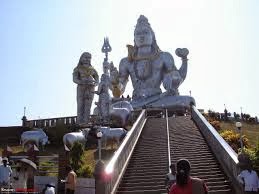Halebid
This ancient capital of Hoysala's
was founded in the early llth century and named Dwarasamudra, after a huge artificial lake
dating back to
9th century. The flourishing capital city had a small fortress with a
magnificent palace. It was fortified with a wall of enormous boulders and a
moat that was connected with the lake.
Halebid HoysaleswaraTemple attained glorious heights during the reign of
Ballala -II, the grandson of Vishnuvardhana. The prosperity of Halebid
attracted the forces of Delhi Sultanate, who invaded and anrexed the town in
1311. In 13 26, it was again attacked and rav^ ,ed by the forces of Mohammad
bin Tughlak. Repeated invasions and the killing of king Ballala III, in the
battle against the Sultan of Madura in 1342, forced the Hoysalas to relinquish
their beautiful capital, which was then referred as 'Halebid' or the 'Old
Capital'. The Hoysalas built over 150 exquisite temples in southern Karnataka,
but the temples at Halebid, Belur and Somnathpur are considered to be
outstanding.

Tourist Acctration in Halebid
Hoysaleswara Temple : This magnificent shrine dedicated to Lord Shiva is the largest and the
best tuiiong Hoysala temples. Its construction was started in 1121, by
"Ketumalla", one of the officials of Vishnuvardhana and could be
completed only by 1207. The shrine is very similar to the Chenna Keshava temple
at Belur, but its figures are more profusely carved. Even after working
diligently for about a century, there are still some unfinished portions in
this amazing edifice. The sculptural extravaganza has been lavishly praised by
the experts, critics and common visitors. The complex consists of two identical
temples, each with its own array of'navranga and sukhanasi and Nandi mandapas.
Both the sanctums have a characterstic star shaped ground plan and are set on a
stone platform as seen in other Hoysala shrines. The temple on the northern
side is named Shantaleshwara, after Shantala Devi, the beloved queen of
Vishnuvardhana, while the southern side shrine is the Hoysaleswara temple. The
two temple halls are joined by a common verandah creating a spacious columned
interior. Thousands of intricately carved sculptures depicting scenes from the
mythological epics Ramayana, Mahabharta, puranic legends, beasts and beauties
etc. adorn the temple walls. There are about thirty five thousand sculpted
pieces in the shrine, noted for their breathtaking beauty, but the south doorway
unrivalled for its filigree work is considered to be a masterpiece of delicate
carving. The central figure portrays Lord Shiva with demon Andhakasur under his
feet, while on the either side of the lintel are Hoysala motif depicting a man
single-handedly fighting a tiger.
Both
the sanctums enshrine a east facing lingam, Preceded by a Nandi mandapa with a
huge statue of j Nandi bull, the celestial vehicle of Lord Shiva. There is an
Archaeological Museum in front of the Hoysaleswara temple. Other attractions of
Halebid Kedareswara Temple, Basadi Halli (Jainrines),and Sri Ranganatha Temple.
REACHING THE
Airport . Mangalore ( 170 kms.).
Rail head : Hassan (33 kms.). ;
Road : It is 16 kms. east of Belur
and well connected by road. Bangalore is about 220 kms.












































